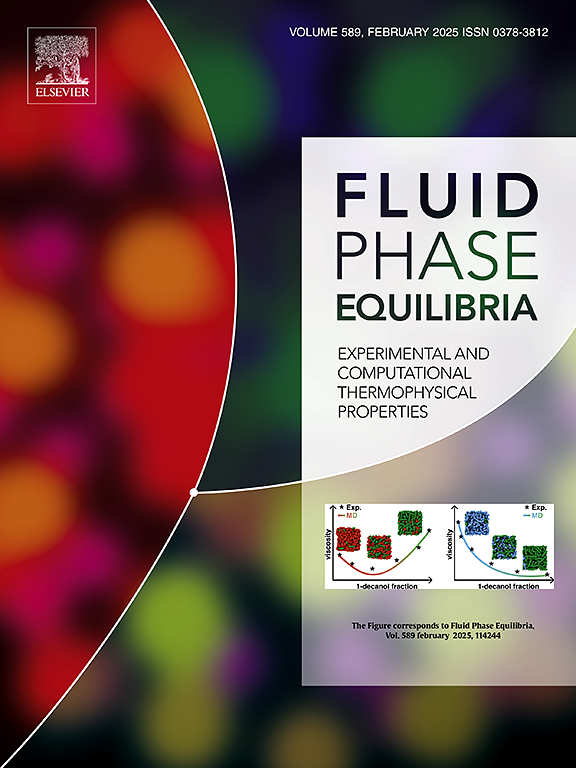Lennard-Jones样条流体的黏度、热导率和自扩散系数:短程势理论的评价
IF 2.7
3区 工程技术
Q3 CHEMISTRY, PHYSICAL
引用次数: 0
摘要
Lennard-Jones/spline (LJ/s)势被截断和样条化,使得势和它的一阶导数在≈1.74σ处连续趋近于零,使得它是短距离的。在这项工作中,我们提出了一个系统的研究热导率,剪切粘度和自扩散系数的LJ/s流体。通过比较温度在0.7≤T∗≤10范围内和密度在0.1≤ρ∗≤0.8范围内的平衡和非平衡分子动力学模拟结果,对四种理论进行了评价。在以氩气为基准流体的扩展对应态理论中,对每个输运性质的两个参数进行回归后,粘度和导热系数与模拟数据的平均绝对相对偏差(AARDs)分别为4.7%和2.8%。使用4-6个回归参数,残余熵标度对黏度、导热系数和自扩散系数的误差分别为5.7%、2.6%和2.5%。将熵标度的概念与扩展的对应态形式化相结合,提出了一种新的方法——对应熵态理论。在没有任何拟合参数的情况下,以氩气为基准流体,该方法得到的黏度和导热系数的aard分别为5.2%和2.6%。对于剩余熵标度、扩展对应态和对应熵态,最大的偏差是在临界点附近的粘度,这可以用状态方程的不准确性来解释。修正的Enskog理论是完全可预测的,它给出了T∗≥3的AARDs低于10%,直到ρ∗=0.4。要提高修正的Enskog理论在较低温度和较高密度下的准确性,还需要做更多的工作。本文章由计算机程序翻译,如有差异,请以英文原文为准。
Viscosity, thermal conductivity and self-diffusion coefficient of the Lennard-Jones spline fluid: Evaluation of theories for a short-ranged potential
The Lennard-Jones/spline (LJ/s) potential is truncated and splined such that the potential and its first derivative continuously approach zero at , making it short-ranged. In this work, we present a systematic study of the thermal conductivity, shear viscosity, and self-diffusion coefficient of the LJ/s fluid. Four theories are evaluated by comparing to results from equilibrium and non-equilibrium molecular dynamics simulations for temperatures in the range and densities in the range . After regressing two parameters for each transport property in extended corresponding state theory with argon as reference fluid, the Average Absolute Relative Deviations (AARDs) with respect to the simulation data are 4.7% and 2.8% for the viscosity and thermal conductivity respectively. Using 4-6 regression parameters, residual entropy scaling yields AARDs of 5.7%, 2.6%, and 2.5% for the viscosity, thermal conductivity and self-diffusion coefficient respectively. A new method called corresponding entropic states theory is presented, which combines the concept of entropy scaling with the extended corresponding states formalism. Without any fitting parameters and with argon as reference fluid, the viscosity and thermal conductivity from the method have AARDs of 5.2% and 2.6%. For residual entropy scaling, extended corresponding states, and corresponding entropic states, the largest deviations are for the viscosity near the critical point, which can be explained by inaccuracies in the equation of state. Revised Enskog Theory, which is fully predictive, gives AARDs below 10% for , up to . More work is needed to increase the accuracy of Revised Enskog theory at lower temperatures and higher densities.
求助全文
通过发布文献求助,成功后即可免费获取论文全文。
去求助
来源期刊

Fluid Phase Equilibria
工程技术-工程:化工
CiteScore
5.30
自引率
15.40%
发文量
223
审稿时长
53 days
期刊介绍:
Fluid Phase Equilibria publishes high-quality papers dealing with experimental, theoretical, and applied research related to equilibrium and transport properties of fluids, solids, and interfaces. Subjects of interest include physical/phase and chemical equilibria; equilibrium and nonequilibrium thermophysical properties; fundamental thermodynamic relations; and stability. The systems central to the journal include pure substances and mixtures of organic and inorganic materials, including polymers, biochemicals, and surfactants with sufficient characterization of composition and purity for the results to be reproduced. Alloys are of interest only when thermodynamic studies are included, purely material studies will not be considered. In all cases, authors are expected to provide physical or chemical interpretations of the results.
Experimental research can include measurements under all conditions of temperature, pressure, and composition, including critical and supercritical. Measurements are to be associated with systems and conditions of fundamental or applied interest, and may not be only a collection of routine data, such as physical property or solubility measurements at limited pressures and temperatures close to ambient, or surfactant studies focussed strictly on micellisation or micelle structure. Papers reporting common data must be accompanied by new physical insights and/or contemporary or new theory or techniques.
 求助内容:
求助内容: 应助结果提醒方式:
应助结果提醒方式:


